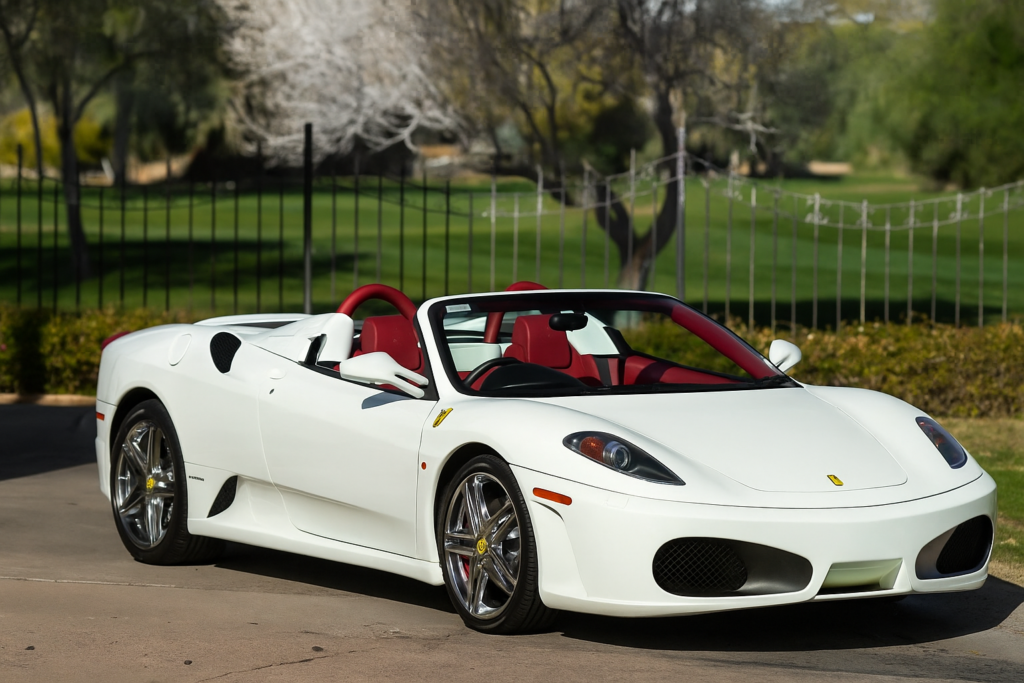The Ferrari F430 (Type F131) costs $191,465. It was produced from 2004 to 2009. The F430 replaced the Ferrari 360 and introduced major advancements in styling, performance, and driving dynamics.
Ferrari unveiled the car at the 2004 Paris Motor Show and produced approximately 16,750 units before introducing the 458 Italia as its successor in 2009.
Also Read:

Specifications of The Ferrari F430
| Spec | Value/Type |
|---|---|
| Engine | 4.3L V8 |
| Engine Displacement | 4308 cc |
| Engine Output | 360 kW, 483 hp |
| Top Speed | 196 mph (315 km/h) |
| 0-60 mph | 3.6 seconds |
Aerodynamics
Pininfarina in collaboration with Frank Stephenson designed the F430 to enhance aerodynamic efficiency while preserving Ferrari’s iconic design language. Although it retained the same aluminum chassis and basic structure as the 360, the F430 appeared significantly more aggressive.
Design
Ferrari integrated styling cues from its racing heritage, including tail lights and engine vents inspired by the Enzo and front air intakes that recalled the 156 F1 “shark nose.” The revised body maintained the same drag coefficient but increased downforce for better handling and high-speed stability.
Powertrain and Performance
Ferrari equipped the F430 with an entirely new 4.3-liter V8 engine from the F136 family, marking a departure from the Dino-derived engines used previously.
This naturally aspirated V8 produced 490 PS (483 hp) at 8,500 rpm and 465 Nm (343 lb-ft) of torque at 5,250 rpm, with 80% of the torque available below 3,500 rpm.
Despite its increased displacement, the engine added just 4 kg in weight, thanks to lightweight components such as newly designed pistons, connecting rods, and crankshaft. The F430 could sprint from 0 to 100 km/h (62 mph) in just 3.6 seconds and exceeded a top speed of 315 km/h (196 mph).
Braking and Handling
Ferrari partnered with Brembo and Bosch to develop advanced braking technology for the F430. The cast-iron brake discs used a new alloy containing molybdenum to improve heat dissipation. Ferrari also offered an optional Carbon Ceramic Brake (CCB) package, which provided fade-free performance even under extreme track conditions.
The F430 introduced the E-Diff, an electronic limited-slip differential that adjusted torque distribution based on steering angle and lateral acceleration. Ferrari also debuted the manettino control knob, allowing drivers to toggle driving modes that adjusted ESC, suspension, throttle response, and E-Diff settings.
Variants of The Ferrari F430
F430 Spider
Ferrari revealed the convertible F430 Spider at the 2005 Geneva Motor Show. It used a two-stage automatic folding mechanism to stow the roof above the engine bay. The Spider shared its engine and chassis with the coupé but weighed slightly more, resulting in a marginal reduction in top speed by 5 km/h (3 mph).
430 Scuderia
Ferrari launched the 430 Scuderia in 2007 as a lightweight, high-performance variant. Unveiled by Michael Schumacher, the Scuderia weighed 100 kg less than the standard model and produced 510 PS (503 hp). It featured revised intake and exhaust systems, along with an advanced knock-detection setup.
The Scuderia accelerated from 0 to 100 km/h in 3.6 seconds and topped out at 319 km/h (198 mph). Ferrari enhanced the single-clutch F1 transmission with “Superfast2” software, achieving 60-millisecond shift times.
Scuderia Spider 16M
To celebrate its 16th Formula 1 Constructors’ Championship, Ferrari introduced the Scuderia Spider 16M in 2009. Based on the 430 Scuderia, this limited-edition convertible featured carbon fiber components, lighter bumpers, and forged wheels.
It weighed 80 kg less than the F430 Spider and accelerated to 100 km/h in 3.7 seconds. Ferrari produced only 499 units, all sold to select clients.
Special Editions
F430 Spider Bio Fuel
Ferrari showcased a biofuel-compatible F430 Spider at the 2008 Detroit Auto Show. It ran on ethanol and produced 500 hp, offering a 4% torque increase and a 5% reduction in CO₂ emissions compared to the standard model.
Ferrari SP1
The SP1 marked Ferrari’s first one-off under the Special Projects Programme. Designed by Leonardo Fioravanti for Japanese collector Junichiro Hiramatsu, the SP1 reimagined the F430 with unique styling while retaining its mechanical foundation.
References
- Ferrari F430 – Wikipedia
- Ferrari F430 Specs – caranddriver
- Ferrari F430 2004 – Ferrari



